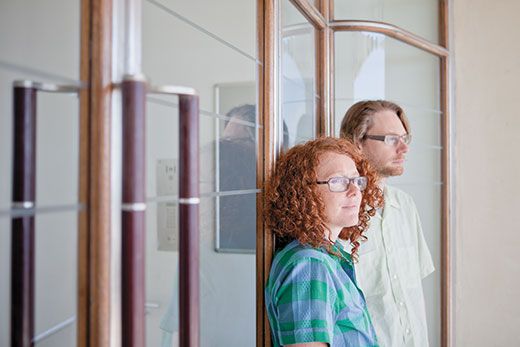Semiconductor on Volcanic Inspiration
The British performance artists discuss how their research on volcanoes will inform their newest works
/https://tf-cmsv2-smithsonianmag-media.s3.amazonaws.com/filer/mall-semiconductor-ruth-jarman-joe-gerhardt-NMNH-631.jpg)
Ruth Jarman and Joe Gerhardt, the British performance artists better known as Semiconductor, are developing a multimedia piece about volcanologists. They recently completed a fellowship at the Natural History Museum—part of a program that allows artists to collaborate with Smithsonian experts in a variety of disciplines. Jarman and Gerhardt corresponded with the magazine’s Jeff Campagna.
You began as musicians, giving live performances?
Yes, but we were really visual artists in disguise. It wasn’t long before we started combining moving images with our music, creating a medium that went far beyond choreographed video and was closer to “synesthesia”—simultaneously stimulating multiple senses. It was then that our understanding of the links between light and sound started to merge with science, as we explored all the ways they crossed paths.
Do they cross paths often?
The phenomenon of projected light and sound has been developed by both science and art over the years, each dependent on the other. As that continues, cinema in the future will place the audience in fully immersive environments. It’s a trend we already see, with the recent popularity of 3-D films and the virtual worlds you find in computer games.
What was a typical day for you at the National Museum of Natural History?
We were based in the Department of Mineral Sciences, researching the science underlying the origins of the solid earth in the form of volcanoes, rocks and minerals. We spent every day in the lab, whether it was to observe the scientists, interview them or collect video material to become part of new works.
Your previous pieces have examined the world in rapid flux. What’s the appeal of geology, a "slow-motion" field of study?
We want to explore the different processes whereby matter is created and reflect on how this field of science can inform our day-to-day experiences, whether it’s the way we experience time or how we reflect upon our place in the larger universe.
After viewing one of your films, what do you want the audience to leave thinking?
We hope to leave both conscious and subliminal marks on our viewers, wherein the way you see the world changes slightly.
/https://tf-cmsv2-smithsonianmag-media.s3.amazonaws.com/accounts/headshot/Jeff-Campagna-240.jpg)

/https://tf-cmsv2-smithsonianmag-media.s3.amazonaws.com/accounts/headshot/Jeff-Campagna-240.jpg)